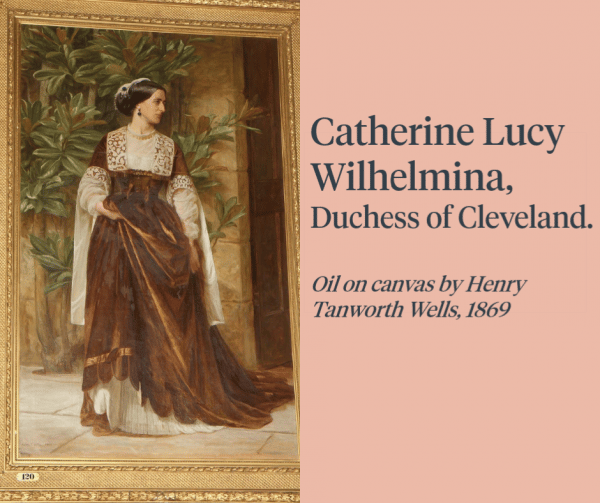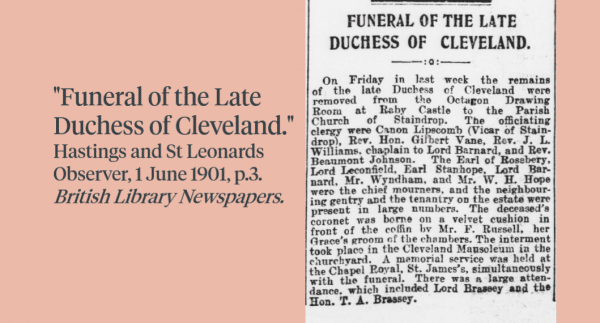This summer, a very special piece of research has been taking place at Raby Castle. Funded by the British-Irish Furniture Makers Online (BIFMO), the project brought together two research students working on either side of the Atlantic Ocean. Postgraduate students Cara Caputo, studying American Material Culture at Winterthur and Andrea Gonzales, studying Art Gallery and Museum Studies at Leeds University were selected from a number of applicants to the scheme. Although they have never met in person, their outstanding teamwork has created a fascinating blog exploring Raby Castle’s Octagon Drawing Room, in their own words.

Our thanks to BIFMO for funding this project. For more details of their work visit https://bifmo.history.ac.uk/
“In the current guidebook for Raby Castle, the entry for the Octagon Drawing Room focuses mainly on the story of a major 1990s restoration project. While an important aspect of its history and a fascinating point of interpretation, this blog post focuses on the origins of the Octagon Drawing Room, including the people involved in the creation of the room and purposes for which it was used. In order to highlight the original use of the home, research was conducted to place the room and its furnishings in historical context. Were the choices made in the furnishings typical of the time or unusual? How did Raby’s 19th-residents use and enjoy the space?
Through a project funded by the British-Irish Furniture Makers Online (BIFMO), this blog post uses source material to explore these questions, emphasize new perspectives, and ultimately, to capture the room in a moment at a time, through the words of someone who lived and entertained in this room and among these objects.

In 1854, Catherine Lucy Wilhelmina Stanhope married Sir Harry George Powlett, the 4th Duke of Cleveland. After their marriage, Catherine became the Duchess of Cleveland and mistress of Raby Castle. In 1870, she authored a handbook for Raby Castle that essentially functions as a guided tour of the Castle, Park and Gardens. Throughout the handbook, the Duchess offers her opinion on aspects of the interior spaces and their furnishings, created by previous generations. Excerpts from her section on the Octagon Drawing Room serve as the narration for this blog post.
Directions: Click on the dots in the picture below to explore various aspects of the room and learn more about the original function and use of Raby’s Drawing Room. To make the picture full screen, click on the two arrows in the bottom right-hand corner.
The Duchess’ Handbook offers a glimpse into how those who were most familiar with the Drawing Room viewed and used this space. Among entertaining and formal use, the Drawing Room served one last unique purpose for the Duchess as after her death it was the setting for her formal visitation. On June 1, 1901, the Hastings and St. Leonards Observer reported the funeral of the “Last Duchess of Cleveland,” stating that her remains were “removed from the Octagon Drawing Room at Raby Castle to the Parish Church of Staindrop.”

Exploring the previous iterations of the room and comparing them to the Drawing Room’s current, now-restored, state reveals the layered and nuanced history of this space. Not only did those who designed and furnished the space play a role in shaping the Drawing Room’s history, but those who lived among it, or merely visited it, have also left an impact and impression on the space. As a room in a private residence often opened to the public, the Octagon Drawing Room remains a dynamic space even today.
Though open to the public, the Lord and Lady Barnard are committed to welcoming visitors as guests to Raby Castle. Their approach encourages visitors to feel as though you could pick up a cushion and park yourself on a couch with a good book and the light of the fireplace to keep you company. Naturally, the furniture is carefully maintained, but the ambiance is very inviting. Through parties and COVID-19, the castle nearly seems to have been untouched by the passage of time. This is glaringly obvious in the Octagon Drawing Room. In fact, it seemed out of date even for the duchess herself! But no one can deny, walking into that room is a breathtaking experience, with everything glittering in the light as the red and gold tones create a warm yet opulent vibe”.
If you’d like to find out more about our Octagon Drawing Room, read our previous blog to find out how our team cares for the ornate collections during the winter months when the Castle is closed to the public. Or delve into the history of our grand Entrance Hall.

